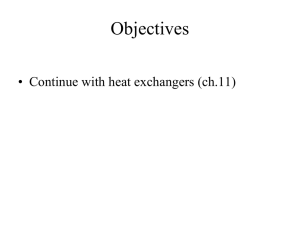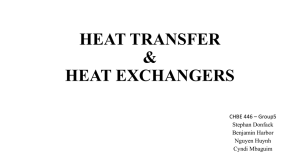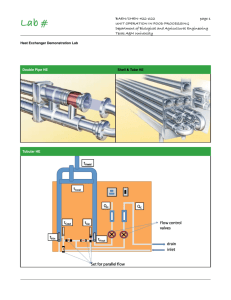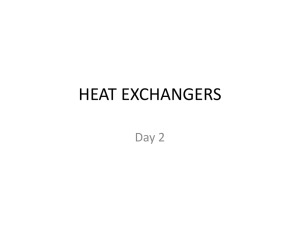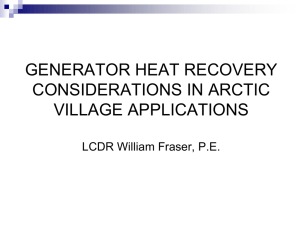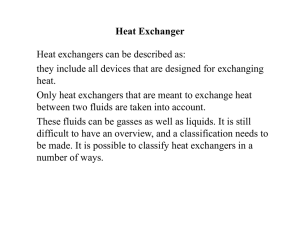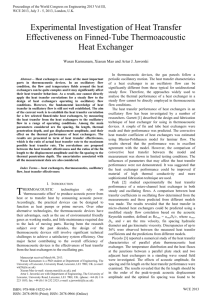Objectives
advertisement
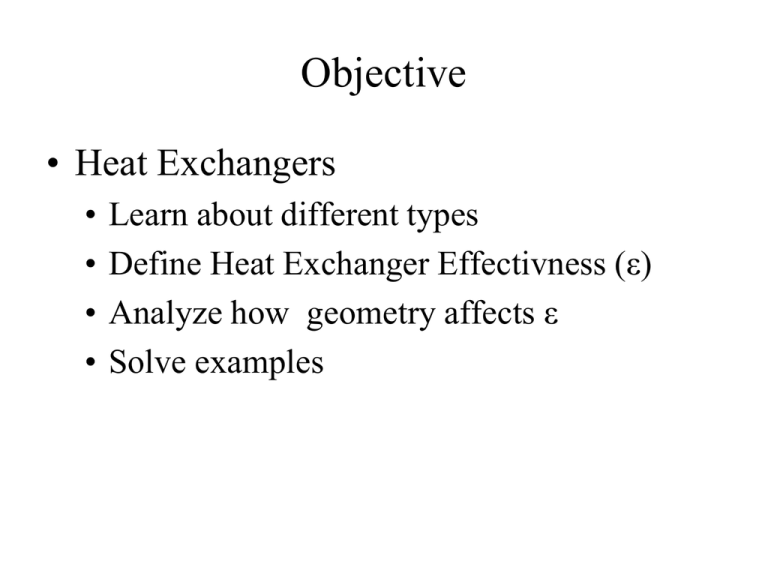
Objective • Heat Exchangers • • • • Learn about different types Define Heat Exchanger Effectivness (ε) Analyze how geometry affects ε Solve examples Systems: residential Outdoor Air Indoor Air Large building system Chiller Large building system Chiller Outdoor air 95oF 53oF Water from building Water to 43oF building Heat exchangers Air-liquid Tube heat exchanger Air-air Plate heat exchanger Some Heat Exchanger Facts • All of the energy that leaves the hot fluid enters the cold fluid • If a heat exchanger surface is not below the dew point of the air, you will not get any dehumidification • Water takes time to drain off of the coil • Heat exchanger effectivness varies greatly Heat Exchanger Effectivness (ε) C=mcp Mass flow rate Specific capacity of fluid THin Heat exchanged Maximumposible heat exchange TCout THout TCin Location B Location A Example: What is the saving with the residential heat recovery system? Outdoor Air 32ºF 72ºF 72ºF Combustion products 52ºF Exhaust Furnace Fresh Air Gas For ε=0.5 and if mass flow rate for outdoor and exhaust air are the same 50% of heating energy for ventilation is recovered! For ε=1 → free ventilation! (or maybe not) Air-Liquid Heat Exchangers Extended surfaces (fins) from air side • Fins added to refrigerant tubes Analysis of Compact Heat Exchangers • Geometry is very complex • Assume flat circular-plate fin Overall Heat Transfer Q = U0A0Δtm Overall Heat Transfer Coefficient Mean temperature difference Δtm for Heat Exchangers Depends on flow direction: • Parallel flow • Counterflow • Crossflow Ref: Incropera & Dewitt (2002) Heat Exchanger Analysis - Δtm Counterflow tm or th,o tc,i th,i tc,o th,o tc,i ln t t h,i c,o t m t B t A t B ln t A Logarithmic mean temperature difference For parallel flow is the same t m t B t A t B ln t A Counterflow Heat Exchangers th,o tc,i th,i tc,o tc,o tc,i R 1 tm t ln th,o tc,i th,i tc,o Important parameters: t h , i t h, o R tc,o tc,i tc, o tc ,i P th,i tc,i m 1 P ln 1 RP Example Assume that the residential heat recovery system is counterflow heat exchanger with ε=0.5. Calculate Δtm for the residential heat recovery system if : mcp,hot= 0.8· mc p,cold Outdoor Air 32ºF mc p,cold 72ºF mcp,hot= 0.8· mc p,cold 72ºF Combustion products Exhaust Furnace Fresh Air th,i=72 ºF, tc,i=32 ºF For ε = 0.5 → th,o=52 ºF, tc,o=48 ºF Δtm,cf=(20-16)/ln(20/16)=17.9 ºF 0.2· mc p,cold What about crossflow heat exchangers? Δtm= F·Δtm,cf Correction factor Δt for counterflow Derivation of F is in the text book: ……… Example: Calculate the real Δtm for the residential heat recovery cross flow system (both fluids unmixed): For: th,i=72 ºF, tc,i=32 ºF , th,o=52 ºF, tc,o=48 ºF R=1.25, P=0.4 → From diagram → F=0.92 Δtm= Δtm,cf · F =17.9 ·0.92=16.5 ºF Overall Heat Transfer Q = U0A0Δtm Need to find this AF AP,o 1 1 U0 Ro RInternal Rcond Pipe RExternal Heat Transfer Heat transfer from fin and pipe to air (External): Q hc ,o AP ,o (t P,o t ) hc ,o AF (t F,m t ) Q hc ,o AP ,o AF (t P,o t ) where t (eq.1) (tF , m t ) /(tF , B t ) is fin efficiency Heat transfer from hot fluid to pipe (Internal ): Q hi AP,i (t f tP,i ) (eq. 2) Heat transfer through the wall: k P AP,m (t P,i t P,o ) Q (eq. 3) xP tF,m tP,o Resistance model Q = U0A0Δtm From eq. 1, 2, and 3: U0 1 Ao AP ,i hi R Internal Ao x p AP ,m k p R cond-Pipe 1 AP ,o hc ,o A F hc1,o R External • We can often neglect conduction through pipe walls • Sometime more important to add fouling coefficients Example The air to air heat exchanger in the heat recovery system from previous example has flow rate of fresh air of 200 cfm. With given: h Internal 10 Btu/hsfF, R cond 0.002sfF/Btu/h , h External 10 Btu/hsfF Calculate the needed area of heat exchanger A0=? Solution: Q = mcp,cold Δtcold = mcp,hot Δthot = U0A0Δtm From heat exchanger side: Q = U0A0Δtm → A0 = Q/ U0Δtm U0 = 1/(RInternal+RCond+RFin+RExternal) = (1/10+0.002+0+1/10) = 4.95 Btu/hsfF Δtm = 16.5 F From air side: Q = mcp,cold Δtcold = = 200cfm·60min/h·0.075lb/cf·0.24Btu/lbF·16 = 3456 Btu/h Then: A0 = 3456 / (4.95·16.5) = 42 sf For Air-Liquid Heat Exchanger we need Fin Efficiency • Assume entire fin is at fin base temperature • Maximum possible heat transfer • Perfect fin • Efficiency is ratio of actual heat transfer to perfect case (tF , m t ) /(tF , B t ) • Non-dimensional parameter tF,m Fin Theory k – conductivity of material hc,o – convection coefficient pL=L(hc,o /ky)0.5 Reading Assignment • Chapter 11 - From 11.1-11.7 Final project topics • Beside 3 introduced in last class: • Duct design • DOAS design • VAV design
